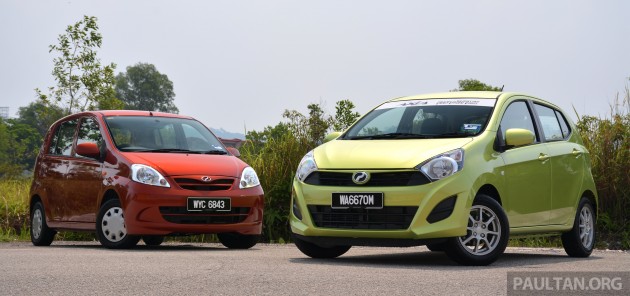
It's hard to measure advancement without proper context. This is doubly true for the new Perodua Axia. It's easy to look down on a car as relatively cheap and basic as this. It is. But it's only until you compare it against the model it replaces – the Perodua Viva – that you start to grasp the full picture. So, Perodua Axia vs Viva, here we go.
The Axia Standard G Auto here now goes for RM33,200, while the Viva S Auto carried a price of RM29,900, and that's after it was slashed by RM5,300 last June. When it was first introduced with the rest of the S-Series models in 2013, you had to pay RM35,200 for one - RM2,000 more than the equivalent Axia.
Equivalent isn't really the right word to use here, of course, as it's an improvement in every measurable way. The Axia is both longer and wider (by 65 mm and 145 mm respectively), and it has a 60 mm-longer wheelbase. Its 260 litre boot is significantly larger than the Viva's 146 litre cargo capacity, and that's with the space saver spare tyre upgraded to a full size unit too.
On the outside, the Axia gains 14-inch alloy wheels with 175/65R14 tyres instead of 12-inch steel rims with 155/70R12 rubber on the Viva. The older car's lift-type door handles have been banished altogether, and the rear lights now have LED illumination. The old school key and remote control fob have been replaced by an integrated unit too.
Inside, it's a world of difference. The instrument panel now has a modern cowled-in design as opposed to the Viva's flat meters, and the standard single-DIN CD/radio player has been superseded by a neatly integrated double-DIN head unit in the Axia. The window switches on passenger doors no longer look like an afterthought either.
Crucially, the Axia has three-point seat belts for all passengers instead of the Viva's centre lap belt, and Isofix mounts for child seats are now present. Improvements also include new innovations such as the rear seat hooks, anti-snatch hook for handbags and a tissue compartment behind the front passenger seat.
Under the hood, the Axia has a 66 hp/90 Nm all-aluminium 1KR-DE2 1.0 litre engine, which compares favourably against the 60 hp/90 Nm cast iron EJ-VE 1.0 litre motor in the Viva. DVVT variable valve timing is no more, but the new mill is Euro IV-compliant instead of Euro II, and is more economical to boot.
Take a look at the two cars yourself in our comprehensive comparison galleries below. Still think that the new Perodua Axia is underwhelming? Well, think again.
Perodua Axia Standard G
Perodua Viva S-Series

No comments:
Post a Comment